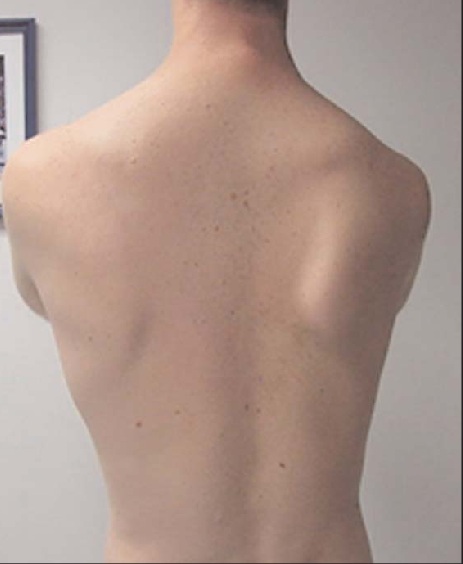We all know swimmers have to be strong. By nature, swimming is resistance training. Every time a swimmer moves through the water, that swimmer is moving against water resistance. So, it stands to reason that muscles like the lats, pecs, and quads need to be strong.
This is exactly why you’ll see these muscles become overdeveloped in swimmers. How do we know the lats and pecs become overdeveloped? Outside of an actual assessment, just taking a look at resting posture is typically a dead giveaway. You’ll typically see the palms of the hands face behind the athlete, more rounding of the upper back, and the fronts of the shoulders sitting forward from a side angle. Here’s an example of that:
The muscles we’re discussing here are not the pecs, lats, or quads, though; they’re the serratus anterior and the subscapularis.
The majority of swimmers tend to have flat thoracic spines. At first glance, it is common the think they have overly rounded (kyphotic) upper backs due to the rounding of the shoulders. Upon a closer look, you’ll find the most of them with flat spines between their shoulder blades. The issue with having a flat upper back is that for the shoulder blade, which is curved, to sit snugly against the thorax, the upper back also has to have curvature. If the shoulder blade doesn’t have that firm fit against the thorax, the body has to compensate to provide stability to an unstable area. Trying to produce force through the upper body with a shoulder blade/thorax relationship like this has often been compared to shooting a cannon out of a canoe. The shoulder blade needs to be adequately stabilized against the thorax in order for the upper body to do its job well.
When we do have a poor fit between the scapula and the thorax, it will cause the shoulder blade to move forward and up due to overactivity of the pecs and upper traps. You’ll often see this manifested as a winging scapula. As a result of this, a key shoulder muscle, the serratus anterior, becomes disengaged.
See how the right shoulder blade is winging off of the body?
When the pecs and lats become overdeveloped, they cause the arms to internally rotate. This will, in turn, cause the rotator cuff to externally rotate the arm. The subscapularis is an internal rotator of the shoulder (as well as an anterior stabilizer), so the externally rotated compensation inhibits the subscapularis (1). This is not good!
So, what does all of this mean? Well, a weak or inhibited subscapularis and serratus anterior are implicated as a cause of shoulder impingement and pain with swimmers (2). With the primary muscle that keeps the ball from slipping forward in the socket inhibited (subscapularis), it’s not uncommon for the shoulder to become unstable and translate forward and up (anterior and superior) in the socket. This translation can lead to worse injuries than just shoulder impingement, such as a labral tear.
What do you do if you’re a swimmer and you have shoulder pain? First and foremost, it’s a good idea to get assessed by a physical therapist who works with swimmers and other overhead athletes and knows the shoulder well. It’s shocking how many swimmers we have worked with who have been to a physical therapist or chiropractor who have never had a thorough assessment looking at rib cage position, resting shoulder blade position, neck position, and shoulder motion thoroughly.
The thing with shoulders is that pain is going to arise from essentially one thing: the ball (humerus) and socket (shoulder blade) not moving well together. The difficult part is figuring out what’s not moving correctly and how to fix it.
When we work with swimmers in pain, we’ll assess them first. After that, our program will be tailored to work with that swimmer pain-free (of course), but also to integrate activities help the issue at hand. Here are a few exercises we tend to do with swimmers that have painful shoulders that encompasses a lot of what has been previously discussed.
Modified All Fours Belly Lift w/ Hands Forward
PRI Wall Supported Squat w/ Balloon
All Fours Intercostal & Lat Inhibition
Foam Roller Serratus Wallslide
TRX Serratus Slide
Prone 1-Arm Internal Rotation
This is just the tip of the iceberg in working with swimmers with shoulder pain. The main thing we’re concerned with is finding pain-free movements and making sure we’re focused on keeping the shoulders healthy and the right muscles working. Once that happens, it’s smooth sailing to getting our athletes strong and fast!
Interested in our completely individualized approach to dryland training? Click to learn more about our swim dryland training and to schedule your evaluation!
References
Berge, T. Swimming: An In-Depth Look at Mechanics, Pathomechanics and Management with a PRI Perspective.
Scovazzo, M., Brown, A., Pink, M., Jobe, F., & Kerrigan, J. The Painful Shoulder During Freestyle Swimming: An electromyographic and cinematographic analysis of twelve muscles. Am J Sports Med, 1991 19(6), 577-582.








